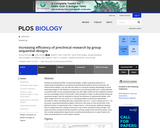
Despite the potential benefits of sequential designs, studies evaluating treatments or experimental manipulations in preclinical experimental biomedicine almost exclusively use classical block designs. Our aim with this article is to bring the existing methodology of group sequential designs to the attention of researchers in the preclinical field and to clearly illustrate its potential utility. Group sequential designs can offer higher efficiency than traditional methods and are increasingly used in clinical trials. Using simulation of data, we demonstrate that group sequential designs have the potential to improve the efficiency of experimental studies, even when sample sizes are very small, as is currently prevalent in preclinical experimental biomedicine. When simulating data with a large effect size of d = 1 and a sample size of n = 18 per group, sequential frequentist analysis consumes in the long run only around 80% of the planned number of experimental units. In larger trials (n = 36 per group), additional stopping rules for futility lead to the saving of resources of up to 30% compared to block designs. We argue that these savings should be invested to increase sample sizes and hence power, since the currently underpowered experiments in preclinical biomedicine are a major threat to the value and predictiveness in this research domain.
- Subject:
- Biology
- Life Science
- Material Type:
- Reading
- Provider:
- PLOS Biology
- Author:
- Alice Schneider
- Andre Rex
- Bob Siegerink
- George Karystianis
- Ian Wellwood
- John P. A. Ioannidis
- Jonathan Kimmelman
- Konrad Neumann
- Oscar Florez-Vargas
- Sophie K. Piper
- Ulrich Dirnagl
- Ulrike Grittner
- Date Added:
- 08/07/2020
